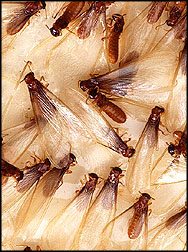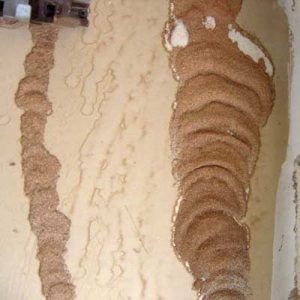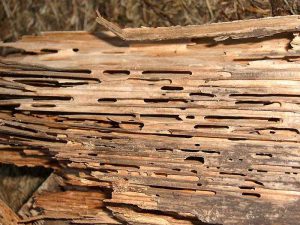Termites
 When it comes to ingenuity, perseverance and sheer strength in numbers, few species can compete with Termites. There are colonies on every land mass on Earth ( with the exception of Antartica ) and one colony can have as many as several million termites. These
When it comes to ingenuity, perseverance and sheer strength in numbers, few species can compete with Termites. There are colonies on every land mass on Earth ( with the exception of Antartica ) and one colony can have as many as several million termites. These
guys aren’t playing around and neither should you. Especially due to the fact that in North America alone, there are 9 species that cause significant damage to structures, homes and even trees. Their priority is wood, your home is made out of wood, need I say more?
Signs of Termites
Luckily for you, most living things leave a trace, you just have to know what to look for.
- As a colony starts the process of decomposition, it has to first excavate to form a path. Eventually it becomes so thin that it breaks and the colony will create a mud – like substance to support. This
 “mud” is the very same that is used to create termite tubes and mounds.
“mud” is the very same that is used to create termite tubes and mounds. - Mud Tunnels or Tubes are a strong indication that there is an infestation, even if they appear to be abandoned. It is possible that the majority of the colony has m
igrated to a different part of the structure. - The misidentification of swarmer termites, often called “flying ants,” can lead to a lax approach when acting to defend your home against termites. If you find them inside your home it is safe to say you have an infestation. However, seeing them outside during summer months or after a heavy rain , it does not mean an infestation has occurred.
- Once swarmers enter their next phase of development, they lose their wings. If you happen upon a random piles of wings, that’s a sign that they are on the move! Albeit, slowly.
- Damaged wood is indicative of the presence of a termite colony. Test the wood, if there is a dull, hollow thud it means that the piece has been compromised.
- Bulging floors, ceilings or walls. This occurs when termites create “satellite” nest in between the joist or wall studs.
Preve nting severe damage
nting severe damage
It is estimated that termites cause $1.5 Billion dollars in structural damage in the United States. Which is more than fire and windstorm damage combined! While termites are populous and persistent, so are humans! All that is required on your end is prying eyes and spry action plans.
- Inspect your hom
e consistently, specifically where wood is present or exposed. - Get ready to get intimate with those crawl spaces around the base of your home. If there is an infestation, that is where you are most likely to find mud tubes and other indications of termites.
- Eliminate wood contact with the ground. Never store firewood or lumber against the foundation of a house.
- Keep moisture away from the foundation of the house and reduce humidity in your basement or crawl space under the house, termites thrive in those types of environments.
There are plenty of alternative ways to prevent termites from colonizing your home. Ranging from nematodes to sand barriers, however, if all else fails. Call a professional, if you are lucky they may bring an adorable termite-sniffing pup!
References
http://www.doityourselftermitecontrol.com/termite-home-inspections.html
https://en.wikipedia.org/wiki/Termite
http://www.thisoldhouse.com/toh/article/0,,609512-3,00.html
https://www.cdc.gov/nceh/publications/books/housing/cha04.htm
